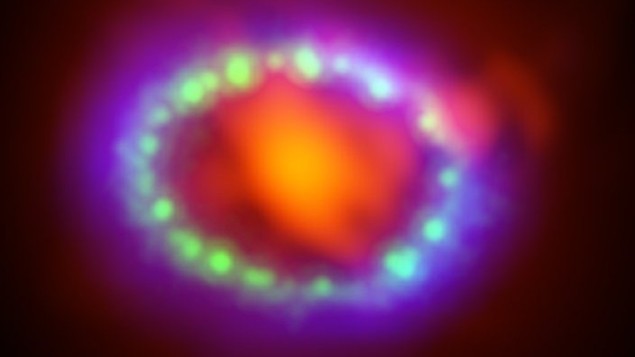
Neutrinos created in exploding stars could point to physics beyond the Standard Model, according to calculations done by Po-Wen Chang and colleagues at Ohio State University in the US. Their work explains how a hypothetical interaction affects the pulse of neutrinos that is generated in a core-collapse supernova – something that could be seen in existing and future observations of supernovae.
Neutrinos are low-mass and electrically neutral subatomic particles that can travel long distances through matter without interacting. They are produced in vast quantities by some astrophysical processes and astronomers use huge detectors to study the neutrinos that arrive on Earth. As well as telling us something about astrophysics, studying these cosmic neutrinos can provide insights into the nature of the particles themselves.
Now, Chang’s team has explored the possibility that supernovae explosions could trigger neutrino behaviours that cannot be explained by the Standard Model of particle physics.
Extreme conditions
The Standard Model says that neutrinos interact with each other via the weak nuclear force or gravity. But during core-collapse supernovae, the particles are expected to become so densely packed that they scatter off each other far more frequently than usual. In such extreme conditions, some theories that go beyond the Standard Model suggest that a hypothetical interaction called “enhanced self-interaction” (νSI), could emerge. This interaction is predicted to be orders of magnitude stronger than the weak interaction and should therefore affect the behaviour of neutrinos in such supernovae.
For astronomers, an opportunity to observe this effect came in 1987, when 25 neutrinos from SN 1987A were registered in three neutrino detectors. SN 1987A was a core-collapse supernova that occurred just 168,000 light–years away in the Large Magellanic Cloud.
The general idea is that νSI should have affected the nature of the neutrino pulse that was detected here on Earth. However, in the decades following the event, physicists have struggled to calculate observable effects in SN 1987A’s neutrino signal that would establish the existence of νSI.
Relativistic hydrodynamics
In their study, Chang’s team revisited the problem by considering neutrinos flowing outwards from the newly forming neutron star at the centre of a core-collapse supernova. Under the constraints of relativistic hydrodynamics, their calculations showed that νSI would cause the particles to act collectively to form a dense, tightly-coupled and expanding fluid.
The researchers also suggest that this expansion could follow two possible paths. In the first scenario, neutrinos would flow out in a sudden burst. The result would be a neutrino fluid that extends far beyond the central neutron star – meaning the neutrino pulse observed by astronomers would last for longer. In the second case, neutrinos instead flow in a steady wind with a lower density. Here, the effects of νSI would disappear closer to the neutron star, resulting in a shorter neutrino pulse.

Some cosmic neutrinos may not be cosmic after all
Chang’s team now hope their ideas will be used in further calculations that could enable astronomers to identify evidence of νSI in neutrino data from SN 1987A. “The dynamics of supernovae are complicated, but this result is promising because with relativistic hydrodynamics we know there’s a fork in the road in understanding how they work now,” Chang says.
Based on their knowledge of neutrino production inside supernovae, the researchers predict that their steady wind theory is more likely than the burst-outflow case – but for now, more work will be needed to determine whether or not both phenomena could occur in the same explosion.
Ultimately, their discoveries could make it far easier for astronomers to gather evidence for νSI once new supernovae are observed in the Milky Way or its galactic neighbourhood – though these may still be decades down the line. “We’re always praying for another galactic supernova to happen somewhere and soon, but the best we can do is try to build on what we know as much as possible before it happens,” says Chang.
The research is described in Physical Review Letters.
- SEO Powered Content & PR Distribution. Get Amplified Today.
- PlatoData.Network Vertical Generative Ai. Empower Yourself. Access Here.
- PlatoAiStream. Web3 Intelligence. Knowledge Amplified. Access Here.
- PlatoESG. Automotive / EVs, Carbon, CleanTech, Energy, Environment, Solar, Waste Management. Access Here.
- PlatoHealth. Biotech and Clinical Trials Intelligence. Access Here.
- ChartPrime. Elevate your Trading Game with ChartPrime. Access Here.
- BlockOffsets. Modernizing Environmental Offset Ownership. Access Here.
- Source: https://physicsworld.com/a/neutrino-fluids-in-supernovae-could-point-to-new-physics/



